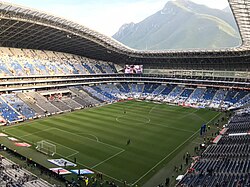| Training site | Hotel |
|---|
| Episcopal High School, Alexandria, Virginia | Hotel AKA Alexandria, Alexandria, Virginia |
| Atlanta United Training Center, Marietta, Georgia | JW Marriott Atlanta Buckhead, Atlanta |
| Austin FC Stadium, Austin, Texas | Four Seasons Hotel Austin, Austin, Texas |
| Florida Atlantic University, Boca Raton, Florida | Boca Raton Marriott at Boca Center, Boca Raton, Florida |
| Boise State University, Boise, Idaho | Courtyard Boise West/Meridian, Meridian, Idaho |
| Riviera Maya Training Site Cancún, Cancún | Moon Palace Cancún, Cancún |
| Mayakoba Training Centre, Playa del Carmen | Fairmont Mayakoba, Playa del Carmen |
| Charlotte FC Training Center, Charlotte, North Carolina | Renaissance Charlotte SouthPark Hotel, Charlotte, North Carolina |
| FC Cincinnati Training Center, Milford, Ohio | Graduate by Hilton Cincinnati, Cincinnati |
| University of South Carolina, Columbia, South Carolina | Graduate by Hilton Columbia, S.C., Columbia, South Carolina |
| Columbus Crew Performance Center, Columbus, Ohio | Le Méridien Columbus, The Joseph, Columbus, Ohio |
| Mansfield Multipurpose Stadium, Mansfield, Texas | Hilton Garden Inn Dallas-Arlington South, Arlington, Texas |
| University of North Texas, Denton, Texas | Embassy Suites by Hilton Denton Convention Center, Denton, Texas |
| FC Dallas Stadium, Frisco, Texas | The Westin Dallas Stonebriar Golf Resort & Spa, Frisco, Texas |
| Texas Christian University, Fort Worth, Texas | Sheraton Fort Worth Downtown Hotel, Fort Worth, Texas |
| The Greenbrier Sports Performance Centre, White Sulphur Springs, West Virginia | Greenbrier Resort, White Sulphur Springs, West Virginia |
| University of North Carolina at Greensboro, Greensboro, North Carolina | Grandover Resort & Spa, A Wyndham Grand Hotel, Greensboro, North Carolina |
| Academia Atlas FC, Zapopan | Grand Fiesta Americana Country Club, Guadalajara |
| Chivas Verde Valle, Zapopan | The Westin Guadalajara, Guadalajara |
| Real Salt Lake Stadium, Sandy, Utah | Asher Adams, Autograph Collection, Salt Lake City |
| Houston Sports Park, Houston | Omni Houston Hotel, Houston |
| Grand Park Sports Campus, Westfield, Indiana | Renaissance Indianapolis North Hotel, Carmel, Indiana |
| Orange County Great Park, Irvine, California | Marriott Irvine Spectrum, Irvine, California |
| University of California, Irvine, Irvine, California | The Ritz-Carlton Laguna Niguel, Dana Point, California |
| Sporting KC Training Center, Kansas City, Kansas | Hotel Savoy Kansas City, Tapestry Collection by Hilton, Kansas City, Missouri |
| KC Current Training Facility, Riverside, Missouri | Hotel Kansas City – The Unbound Collection by Hyatt, Kansas City, Missouri |
| University of Kansas, Lawrence, Kansas | The Oread Lawrence, Lawrence, Kansas |
| Louisville City FC Training Center, Louisville, Kentucky | Hotel Bourre Bonne, Curio Collection by Hilton, Louisville, Kentucky |
| Mercer University, Macon, Georgia | Hotel Forty Five, Macon, Georgia |
| Arizona Athletic Grounds, Mesa, Arizona | Courtyard Mesa at Wrigleyville West, Mesa, Arizona |
| Centro de Alto Rendimiento, Mexico City | Centro de Alto Rendimiento on-site accommodation, Mexico City |
| La Nueva Casa del Fútbol - Toluca, Toluca | DoubleTree by Hilton Toluca, Toluca |
| Rayados Training Center, Santiago, Nuevo León | InterContinental Presidente Monterrey, San Pedro Garza García |
| Coastal Carolina University, Conway, South Carolina | The Ellie Beach Resort, Myrtle Beach, South Carolina |
| Nottawasaga Training Site, New Tecumseth | Nottawasaga Inn Resort & Conference Centre, New Tecumseth |
| Pingry School, Bernards Township, New Jersey | Somerset Hills Hotel, Tapestry Collection by Hilton, Warren, New Jersey |
| Columbia Park, Morristown, New Jersey | The Ridge, Basking Ridge, New Jersey |
| Rutgers University, Piscataway, New Jersey | The Heldrich Hotel and Conference Center, New Brunswick, New Jersey |
| Stockton University, Galloway Township, New Jersey | Sheraton Atlantic City Convention Center Hotel, Atlantic City, New Jersey |
| OKC Professional Soccer Training Facility, Oklahoma City | Skirvin Hilton Hotel, Oklahoma City |
| University of Oklahoma, Norman, Oklahoma | Fordson Hotel The Unbound Collection by Hyatt, Oklahoma City |
| Universidad Del Futbol, San Agustín Tlaxiaca | Camino Real Pachuca, Pachuca |
| Philadelphia Union Stadium, Chester, Pennsylvania | Hotel Du Pont, Wilmington, Delaware |
| University of Portland, Portland, Oregon | The Nines Hotel, Portland, Oregon |
| Estadio Cuauhtémoc, Puebla | Grand Fiesta Americana Puebla Angelópolis, Puebla |
| La Loma Centro Deportivo Querétaro, Querétaro | Hacienda Jurica by Brisas, Querétaro |
| Seattle Sounders FC Performance Center and Clubhouse, Renton, Washington | Hyatt Regency Lake Washington at Seattle's Southport, Renton, Washington |
| St. Louis City High Performance Center, St. Louis | Le Méridien St Louis Clayton, St. Louis |
| Saint Louis University, St. Louis | Chase Park Plaza Hotel, St. Louis |
| San Antonio Stadium, San Antonio | Kimpton Santo Hotel, San Antonio |
| San Diego Jewish Academy, San Diego | Fairmont Grand Del Mar, San Diego |
| Torero Stadium, San Diego | Hyatt Regency La Jolla at Aventine, San Diego |
| Spartan Soccer Complex, San Jose, California | Signia by Hilton San Jose, San Jose, California |
| Oakland Roots/Soul Training Facility, Alameda, California | Claremont Hotel & Spa, Oakland/Berkeley, California |
| Westmont College, Santa Barbara, California | Courtyard by Marriott Santa Barbara Goleta, Goleta, California |
| Bryant University, Smithfield, Rhode Island | Providence Biltmore, Providence, Rhode Island |
| Gonzaga University, Spokane, Washington | Northern Quest Resort & Casino, Airway Heights, Washington |
| Oklahoma State University, Stillwater, Oklahoma | Holiday Inn & Suites Stillwater - University West, Stillwater, Oklahoma |
| Waters Sportsplex, Tampa, Florida | Grand Hyatt Tampa Bay, Tampa, Florida |
| Estadio Caliente, Tijuana | Tijuana Marriott Hotel, Tijuana |
| Estadio Corona, Torreón | Hotel Azul Talavera Country Club, Torreón |
| Kino Sports Complex, Tucson, Arizona | Westward Look Wyndham Grand Resort and Spa, Tucson, Arizona |
| FC Tulsa Training Facility, Tulsa, Oklahoma | DoubleTree by Hilton Hotel Tulsa, Tulsa, Oklahoma |
| National Soccer Development Centre, Vancouver | The Westin Bayshore, Vancouver |
|






















